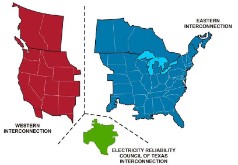Frequency Response Assessment and Enhancement of the U.S. Power Grids towards Extra-High Photovoltaic Generation Penetrations – an Industry Perspective
Abstract
Nonsynchronous generators such as photovoltaics (PVs) are expected to undermine bulk power systems (BPSs)' frequency response at high penetration levels. Though the underlying mechanism has been relatively well understood, the accurate assessment and effective enhancement of the U.S. interconnections' frequency response under extra-high PV penetration conditions remains an issue. In this paper, the industry-provided full-detail interconnection models were further validated by synchrophasor frequency measurements and realistically-projected PV geographic distribution information were used to develop extra-high PV penetration scenarios and dynamic models for the three main U.S. interconnections, including Eastern Interconnection (EI), Western Electricity Coordinating Council (WECC), and Electric Reliability Council of Texas (ERCOT). Up to 65% instantaneous PV and 15% wind penetration were simulated and the frequency response change trend of each U.S. interconnection due to the increasing PV penetration level were examined. Most importantly, the practical solutions to address the declining frequency response were discussed. This paper will provide valuable guidance for policy makers, utility operators and academic researchers not only in the U.S. but also other countries in the world.
- Authors:
-
- Univ. of Tennessee, Knoxville, TN (United States)
- National Renewable Energy Lab. (NREL), Golden, CO (United States)
- Publication Date:
- Research Org.:
- National Renewable Energy Lab. (NREL), Golden, CO (United States); Oak Ridge National Lab. (ORNL), Oak Ridge, TN (United States)
- Sponsoring Org.:
- USDOE Office of Energy Efficiency and Renewable Energy (EERE), Solar Energy Technologies Office (EE-4S), SunShot National Laboratory Multiyear Partnership (SuNLaMP); USDOE
- OSTI Identifier:
- 1424897
- Alternate Identifier(s):
- OSTI ID: 1474552
- Report Number(s):
- NREL/JA-5D00-71056
Journal ID: ISSN 0885-8950
- Grant/Contract Number:
- AC36-08GO28308; AC05-00OR22725
- Resource Type:
- Accepted Manuscript
- Journal Name:
- IEEE Transactions on Power Systems
- Additional Journal Information:
- Journal Volume: 33; Journal Issue: 3; Journal ID: ISSN 0885-8950
- Publisher:
- IEEE
- Country of Publication:
- United States
- Language:
- English
- Subject:
- 14 SOLAR ENERGY; 24 POWER TRANSMISSION AND DISTRIBUTION; bulk power system; inertia; frequency response; frequency nadir; PV
Citation Formats
Liu, Yong, You, Shutang, Tan, Jin, Zhang, Yingchen, and Liu, Yilu. Frequency Response Assessment and Enhancement of the U.S. Power Grids towards Extra-High Photovoltaic Generation Penetrations – an Industry Perspective. United States: N. p., 2018.
Web. doi:10.1109/TPWRS.2018.2799744.
Liu, Yong, You, Shutang, Tan, Jin, Zhang, Yingchen, & Liu, Yilu. Frequency Response Assessment and Enhancement of the U.S. Power Grids towards Extra-High Photovoltaic Generation Penetrations – an Industry Perspective. United States. https://doi.org/10.1109/TPWRS.2018.2799744
Liu, Yong, You, Shutang, Tan, Jin, Zhang, Yingchen, and Liu, Yilu. Tue .
"Frequency Response Assessment and Enhancement of the U.S. Power Grids towards Extra-High Photovoltaic Generation Penetrations – an Industry Perspective". United States. https://doi.org/10.1109/TPWRS.2018.2799744. https://www.osti.gov/servlets/purl/1424897.
@article{osti_1424897,
title = {Frequency Response Assessment and Enhancement of the U.S. Power Grids towards Extra-High Photovoltaic Generation Penetrations – an Industry Perspective},
author = {Liu, Yong and You, Shutang and Tan, Jin and Zhang, Yingchen and Liu, Yilu},
abstractNote = {Nonsynchronous generators such as photovoltaics (PVs) are expected to undermine bulk power systems (BPSs)' frequency response at high penetration levels. Though the underlying mechanism has been relatively well understood, the accurate assessment and effective enhancement of the U.S. interconnections' frequency response under extra-high PV penetration conditions remains an issue. In this paper, the industry-provided full-detail interconnection models were further validated by synchrophasor frequency measurements and realistically-projected PV geographic distribution information were used to develop extra-high PV penetration scenarios and dynamic models for the three main U.S. interconnections, including Eastern Interconnection (EI), Western Electricity Coordinating Council (WECC), and Electric Reliability Council of Texas (ERCOT). Up to 65% instantaneous PV and 15% wind penetration were simulated and the frequency response change trend of each U.S. interconnection due to the increasing PV penetration level were examined. Most importantly, the practical solutions to address the declining frequency response were discussed. This paper will provide valuable guidance for policy makers, utility operators and academic researchers not only in the U.S. but also other countries in the world.},
doi = {10.1109/TPWRS.2018.2799744},
journal = {IEEE Transactions on Power Systems},
number = 3,
volume = 33,
place = {United States},
year = {Tue Jan 30 00:00:00 EST 2018},
month = {Tue Jan 30 00:00:00 EST 2018}
}
Web of Science
Figures / Tables:
 Fig.1: Map of the three U.S. interconnections [9]
Fig.1: Map of the three U.S. interconnections [9]
Works referencing / citing this record:
Improving Microgrid Frequency Regulation Based on the Virtual Inertia Concept while Considering Communication System Delay
journal, May 2019
- Alizadeh, Gholam Ali; Rahimi, Tohid; Babayi Nozadian, Mohsen Hasan
- Energies, Vol. 12, Issue 10
Figures / Tables found in this record:

 Search WorldCat to find libraries that may hold this journal
Search WorldCat to find libraries that may hold this journal